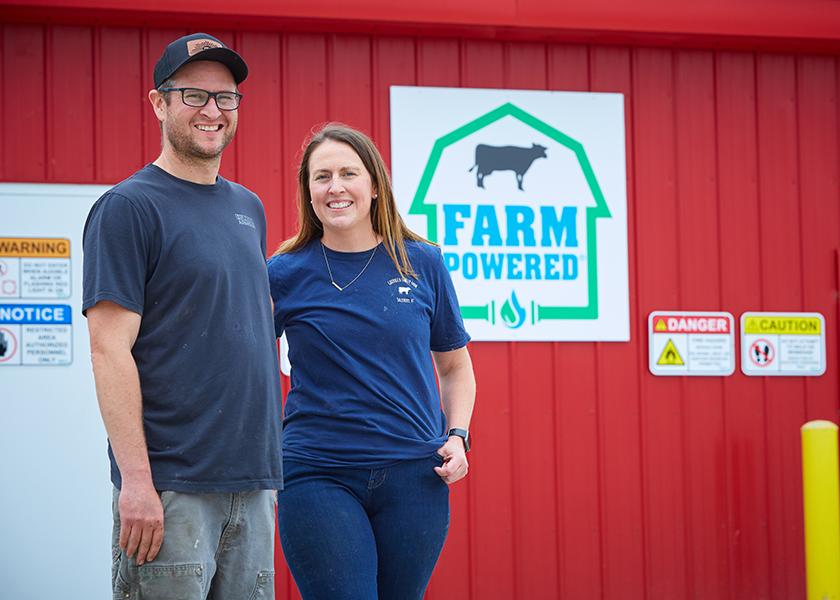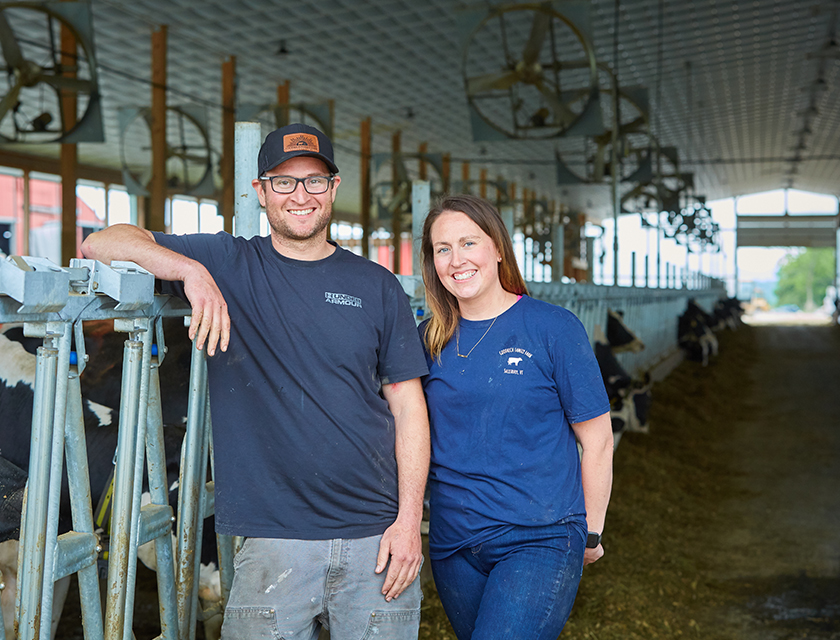Goodrich Farm: A Definition of Sustainability

Most dairy producers remember 2009 — and siblings Chase and Danielle Goodrich are no exception. It was the year the duo transitioned into leadership roles for their family’s third-generation farm in Salisbury, Vermont. The pair realized challenges were on the horizon, but they also understood being good stewards of their resources and pocketbook were the keys to success.
Following in the footsteps of the previous generations, the duo’s drive to outline the farm’s sustainability pillars of environment, economics and society underscores why they were recently recognized as one of the U.S. Dairy 2021 Sustainability Winners.

“Chase and Danielle Goodrich are prime examples of young dairy farmers setting their business on a successful trajectory. Diversifying their farm while further protecting Vermont’s soils and waters is the innovative thinking dairy farmers are known for,” explains Michael DeAngelis, vice president of Integrated Marketing and Communications for New England Dairy. “Their perseverance to see [their anaerobic digester project] come to life is why Goodrich Farm is most deserving of an Outstanding Dairy Farm Sustainability Award. The anaerobic digester has been a long time coming and will serve Vermont, Goodrich Farm and its project partners for years to come.”
Early Beginnings
Chase received a bachelor’s degree in accounting from Salve Regina University, and Danielle attended the Vermont Technical College two-year dairy herd management program. They both finished college at the same time and the opportunity to return home to the family dairy presented itself.
“Danielle always knew she would come back to the farm,” Chase says. “I wasn’t as sure but knew there was potential to utilize my skillset if I did.”
The farm got its start in 1956 by the siblings’ grandparents, Donald and Mildred Goodrich. In the mid-70s, their parents, Ernest and Lee Ann Goodrich joined the farm. Today, Chase oversees the feed and crop side of the business, which includes nearly 2,500 acres of corn and a variety of grasses. His younger sister, Danielle, manages the 800-cow milking herd.
“My sister always liked working with cows and family,” Chase adds. “I liked working with family, too, but really love working the land and having that connection of being part of a rich family farming tradition.”
The siblings give a lot of credit to their father for kickstarting conversations about their dairy’s future.
“In 2009, with the financial crisis facing dairy and in Vermont, a lot of negative criticism was geared toward agriculture’s impact on water quality,” Danielle says. “We knew as a family business we needed to do something to diversify to become sustainable — both economically and environmentally.”
The Environment
For the Goodrich family, sustainability is more than a catchphrase, as they are always searching for ways to be more efficient and improve their operation.
“To me, sustainability means to be able to pass on the tradition of farming to the next generation while also providing for yourself, your family and community,” Chase notes.
Goodrich Farm is located near Otter Creek, which feeds into Lake Champlain. In 2009, the Vermont agriculture industry faced scrutiny when the lake recorded high phosphorus levels. To do their part to improve their local watershed’s water quality and soil health, the Goodriches changed how their operation managed manure and other nutrients.
“We give a lot of credit to our father for being forthright with regulations that were coming at us in the early 2000s,” Danielle says. “We wanted to be part of the solution, not part of the problem.”
The family now uses no-till and cover crops to reduce phosphorus runoff. They’ve also installed satellite ponds that allow the farm to inject manure into the soil to help eliminate compaction and runoff as well as maximize absorption while minimizing odor. A consulting firm helps align the farm’s nutrient management plan with environmental regulations.
“By installing satellite ponds, we can distribute manure to field locations more steadily throughout the year, avoiding surges of trucking before planting and after harvest and improving the impact on our community,” Chase says.
The farm works with a trucking company that manages and operates drag hoses, allowing them to fill tanks from the satellite ponds and directly inject manure on corn and grass ground as often as applicable. A phosphorus removal system applies the nutrients from their dairy on the cropland, with the goal of the operation becoming less reliant on commercial fertilizers.

In partnership with Vermont Gas Systems, Middlebury College and Vanguard Renewables, Goodrich Farm installed an anaerobic digester two years ago. The system includes two 660,00-gal.-capacity tanks that process up to 100 tons of manure and 180 tons of organic food waste into renewable natural gas daily.
“Our exploration around becoming better farmers, stewards of the land and community members brought our dairy farm family together with a prestigious educational institution, with a public utility, several environmental groups and an innovative group of organic waste recycling and renewable energy entrepreneurs,” Chase says. “When we got into the same room, a tremendously beneficial partnership developed with lasting benefits for the farm, the community and the environment.”
The Economics
Before Chase and Danielle came back home, their father began milking on a second facility and added an additional 300 cows.
“This was a good short-term plan,” Danielle says. “We knew we would need more cows at some point.”
In July 2020, the farm consolidated milking operations from older barns at two separate sites to one freestall barn and a 28-cow rotary to cut back on energy costs and labor while enhancing cow comfort and herd health.
“We wanted to maximize efficiencies and have one stream of manure and milk pick-ups to simplify the entire operation,” Chase notes.
This transition did not come without hiccups. The project was delayed a whole year because of COVID-19 and production quotas.
“It was hard to move forward with a business model when market conditions tell you not to build the barn,” Chase adds. “Hindsight is always foresight, and we are glad we pushed forward and built regardless of the challenges presented.”
Today Goodrich Farm milks 800 cows and has produced more than 18 million pounds of milk through their cooperative, Agrimark. Focusing on cow comfort and increasing production while honing in on efficiency has brought success in other facets of the dairy. For example, the herd’s somatic cell count has decreased to under 100,000, which the family credits to using separated solids for bedding rather than sawdust.
“It is really fresh and dry bedding,” Chase says. Stalls are bedded three times weekly and the four-row freestall barn gives cows plenty of room. Add in automated fans and curtains and it’s a consistently good place for cows to live.”
The family notes the digester has saved nearly $50,000 annually on bedding alone. The digester also produces more than 80,000 tons of low-carbon, low-odor organic digestate annually, which saves another $200,000 in commercial chemical fertilizers.
The Society
Accepting unusable food and beverage waste for the digester diverts nearly 66,000 tons of non-farm organic waste from landfills annually. The digester produces 600 kilowatts of renewable electricity annually, which is comparable to heating nearly 5,000 homes on an annual basis.
One of the sibling’s main goals is to carry on the tradition of farming – it’s also part of their definition of sustainability.
“When my sister and I returned to the family farm a dozen years ago, our focus became how we can achieve this sustainable goal.”
Chase and Danielle’s emphasis on being wise stewards of their resources and pocketbook has allowed them to put one foot in front of the other, achieving a sustainable formula that will propel them into the future.







